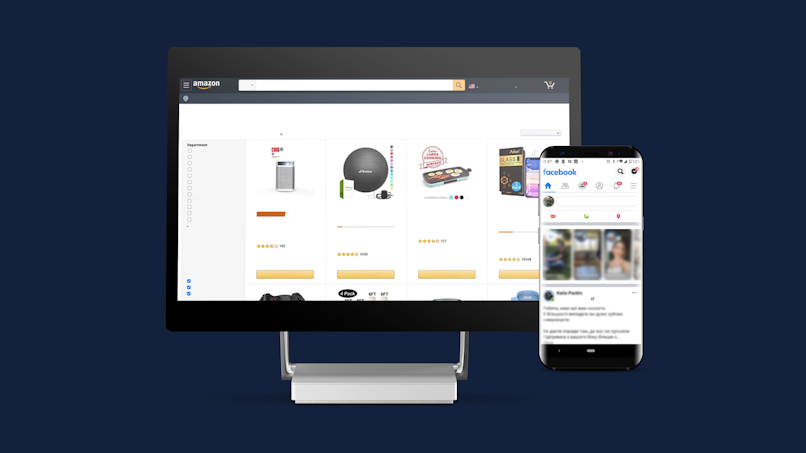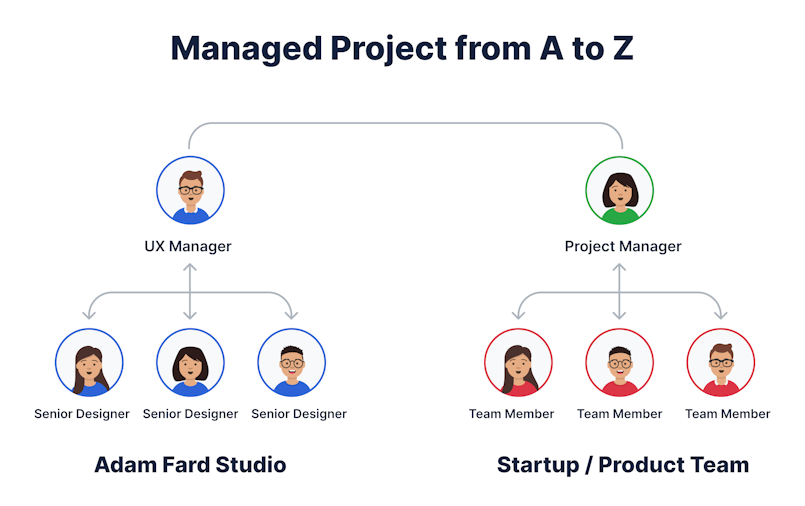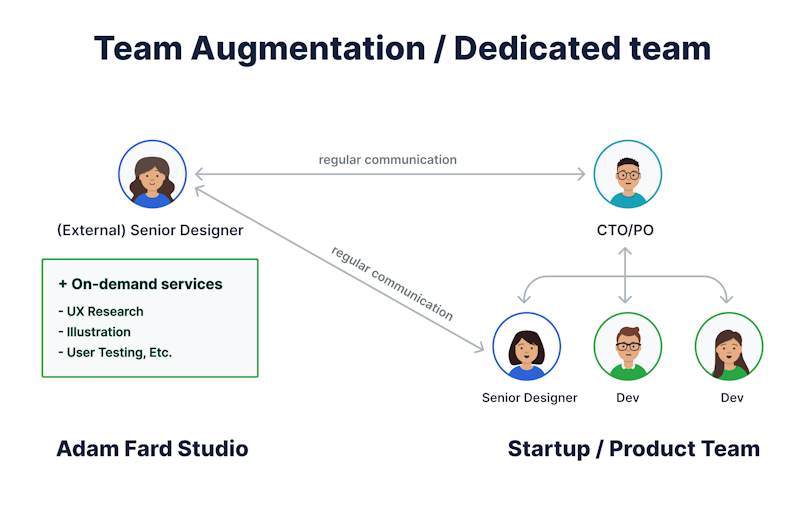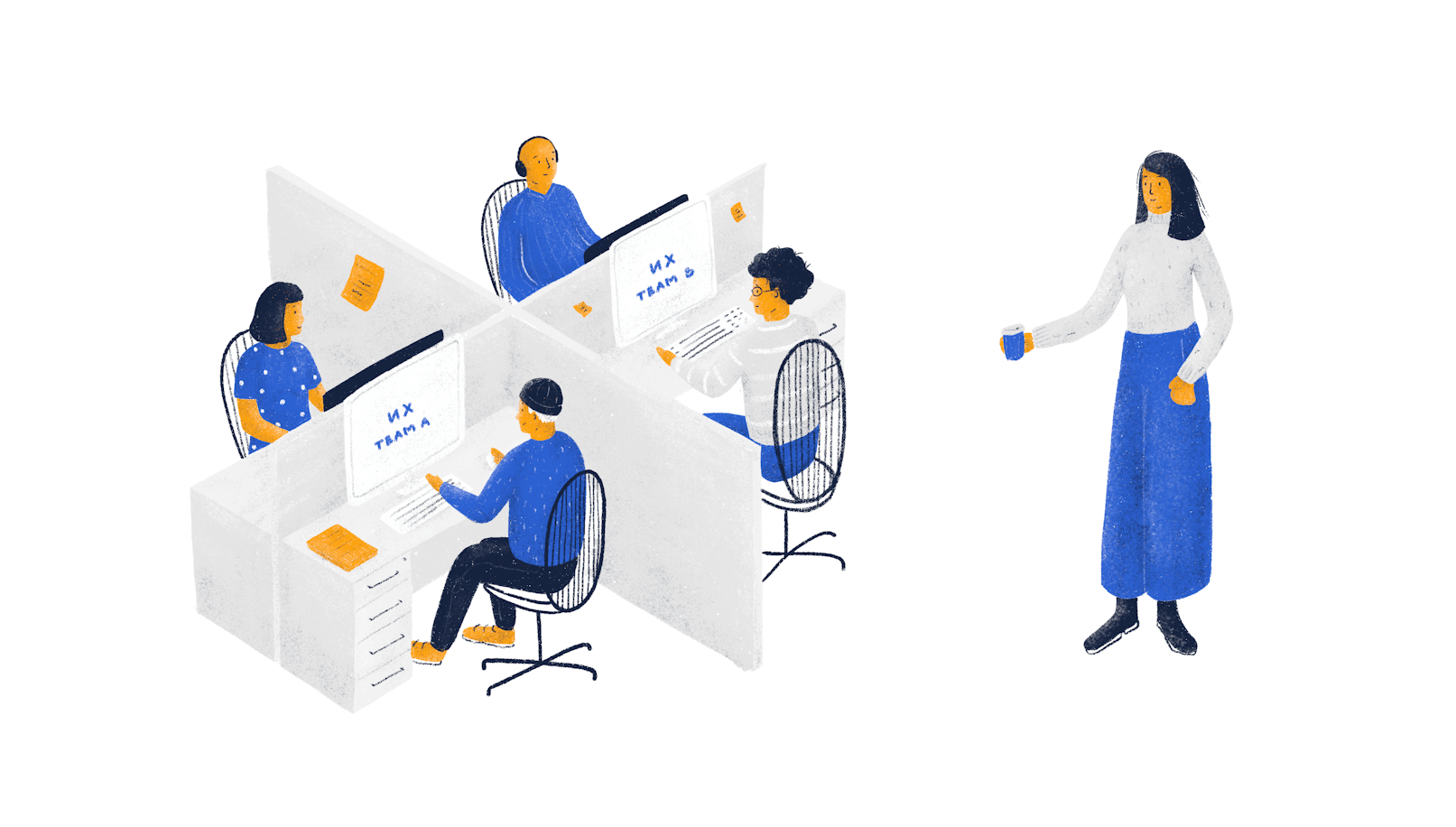Did you know that companies investing in user experience (UX) design see an average return of $100 for every $1 spent? It’s no surprise then that businesses, from startups to global enterprises, are prioritizing UX to gain a competitive edge. Yet, assembling the right UX team is more than just filling roles—it's about creating a structure that ensures collaboration, innovation, and user-centric decision-making.
UX design isn’t just about “making things look pretty” or boosting conversions. It’s a discipline grounded in empathy and research, ensuring that every interaction meets user needs while aligning with business goals. The team behind these designs plays a pivotal role in determining a product’s success or failure.
But how do you structure your UX team? What roles are essential, and how can you adapt as your team grows? In this article, we’ll break down the key roles within a UX team, explore common team structures, and provide actionable insights to help you build a team that drives exceptional design outcomes.
Let’s dive in!
The minimum viable design team
There’s great career diversity in product design. We’ll explore the different specialists that fall under this professional umbrella below, but first, let’s take a look at the essential fronts your team should be able to cover.
Research
Product decision-making in UX is deeply rooted in research data—it’s a central tenet of the craft. If there’s no empathy, there can be no “UX.”
Your team should have people that are experienced in conducting and analyzing research. Obviously, it could be a UX researcher, but often other professionals possess these skills to a certain extent, like UX designers, UX writers, information architects, and others.
The purpose of this phase is to understand the people you design for, comprehend their wants and needs, as well as develop a certain level of familiarity with their expectations. As a result, this leads to the formulation of a product offering that makes sense to them and addresses their needs directly and effortlessly.
User experience design (UX)
Once you’ve collected enough research data and extracted enough actionable insights into your users’ needs, it’s time to start putting pixels together, which is where the actual “design” comes in (however, both are indispensable parts of the UX process). Fundamentally, its purpose is to make a design of digital experience easy to use, useful, pleasant, etc.
UX designers are often tasked with developing wireframes and prototypes, as well as testing and improving them in an iterative manner.
It’s important to think of UX design as something more than just the visual side of things. Instead, it’s all about the decisions made throughout the organization to ensure a frictionless, useful, and ethical experience.
User interface design (UI)
Oftentimes, there’s a single person responsible for both UX and UI. This specialist is often referred to as a product designer or a “UI/UX designer." Things get harder when you also need them to also do research.
Practically speaking, a single person rarely has either the time or the expertise to produce top-notch deliverables in both of these areas. As such, in our experience, the minimum viable team for product design should consist of a product designer and a UX researcher.
Naturally, as the team grows, you’ll be distributing responsibilities in a more granular manner, but we’ll touch more on that in the next chapter.
The breadth of UX talent
Digital product designers come in all shapes or forms. Again, generally, you only need to concern yourself with differentiating the different flavors of UX talent when you have large teams. Let’s quickly go over the most popular types of UX specialists.
UX researcher
The key responsibility of a UX researcher is to supply the design and product team with insights into user behavior. Good UX isn’t built on assumptions. The range of activities a researcher conducts usually includes workshops, user interviews, usability tests, competitor research, etc.
All digital products utilize an interaction layer intended for a human audience. Humans are not infallible and often make mistakes. They may be distracted or be dealing with a heightened level of emotions while navigating digital environments. Therefore, it is crucial that we understand that many modern digital product design challenges and problems stem from the very fact that we are human.
Typically, to do this, they use qualitative and quantitative research methods to ensure a thorough understanding of user needs and market demands.
UX designer
In close collaboration with a UX researcher, the UX designer turns user insights into well-thought-out experiences. These experiences don’t encompass just in-app design—it’s way more extensive than that. From the moment a user learns about your product, they are under a UX designer's watchful eye.
The range of activities UX designers conduct includes the information architecture, user flows, usability testing, customer persona creation, and maintenance.
In large organizations and enterprise product development, the UX designer role is more focused on user experience, usability, and accessibility.
UX designers spend a lot of time understanding behavior, pain points, emotions, and other human factors to deliver products that meet user needs.
UI designer
To be frank, we’re a little skeptical of this role. Yet, despite our lack of conviction, there are people who claim to be UI designers, as well as those who hire them.
Ostensibly, a UI designer, having received wireframes from a UX designer, would color the same way a child paints a coloring book. However, good UI design is meant to reflect your product’s identity and add additional value through delight. Things don’t have to be animated nicely, but when they do, it sure feels nice.
The reason we’re skeptical of the UI designer position is that UI naturally flows out of UX. UI is merely a phase an idea goes through before it gets brought to life.
In a real-world setting, you’ll more often find motion designers, illustrators, and similar professionals doing the job we’ve outlined in this paragraph.
Product designer
For all intents and purposes, you can consider a product designer to do the same thing a UI&UX designer does. Generally, you would find product designers working in product companies (duh), while UI&UX designers tend to work for design agencies.
Information architect
As the name suggests, an Information Architect is responsible for organizing and structuring the content within a product. While UX designers often perform this role, complex products with vast amounts of information—like enterprise software or e-commerce platforms—benefit greatly from a dedicated specialist.
A well-crafted information architecture ensures users can easily find what they need and interact with the product without frustration. Poor architecture, on the other hand, often leads to rework and inefficiencies down the road—a truly bad outcome.
Information Architects spend much of their time studying user behavior through heat maps, analytics, and research data. Then they create sitemaps, navigation models, and hierarchies to ensure the product meets both user and business needs.
For instance, in a massive online retailer like Amazon, an Information Architect ensures that categories, search filters, and navigation paths work seamlessly so users can find what they want quickly.
UX writer
Copy is an extremely important part of modern design—as you can see in the image below, products like Amazon, Airbnb, and Facebook wouldn’t make much sense without it. Therefore, it’s essential to make sure that enough care and attention are invested into finding a good content strategist or UX writer.

Broadly speaking, these professionals are responsible for making copy clear, concise, useful, and on-brand.
Unfortunately, copy often becomes an afterthought in smaller UX teams. As a result, many products end up suffering from poor communication with their users, which leads to loads of friction, confusion, and frustration.
Digital design director
Depending on the size of your UX team, this role may or may not be necessary. However, having someone to lead and inspire the team is always critical.
Digital Design Directors are usually senior-level professionals who bring together a strong understanding of both UX and UI design. They guide a team of specialists, helping them stay aligned with business goals while fostering creativity and innovation.
Beyond managing workflows, digital design directors often advocate for user-centric design at the leadership level. They are instrumental in shaping the design strategy and ensuring that it integrates seamlessly with overall business objectives.
On Structuring Design Teams
Choosing the right structure for your UX team depends on various factors, such as company size, project complexity, and organizational culture. Let’s explore the three common UX team structures—centralized, decentralized, and mixed—and when each might be the best fit, along with real-world examples for clarity.
Centralized Design Teams
In a centralized structure, all UX professionals report to a single UX manager or department. This manager allocates designers to specific projects as needed.
When to Use It:
Best for small to mid-sized organizations with multiple, concurrent projects that require specialized UX input.
Useful when the organization prioritizes consistent UX quality across all products.
Ideal for companies building out their design team and needing clear oversight.
Benefits:
Ensures uniform design standards across projects.
Encourages knowledge sharing and collaboration among team members.
Streamlines professional development with a clear reporting structure.
Challenges:
Designers often juggle multiple projects, which can lead to context-switching and burnout.
Team members may lack deep project-specific knowledge due to fragmented focus.
Example:
Imagine a SaaS company managing a suite of tools (e.g., project management, CRM, and marketing platforms). A centralized UX team ensures design consistency across all tools by establishing a unified design system and providing specialized designers for specific project needs.
Working with an experienced UX design agency often follows a centralized structure. For instance, here’s one way we at Adam Fard Studio collaborate with startups.

Decentralized Teams
In this structure, UX designers are embedded directly within product teams and report to the product manager or team lead. This means a designer is always allocated to an ongoing project in the organization.
When to Use It:
Best for large organizations with multiple product lines or standalone projects.
Works well when each product requires a deep understanding of its users and business goals.
Suitable for organizations with a mature UX culture that values close collaboration between design and development teams.
Benefits:
Designers are fully immersed in their respective projects, leading to a deeper understanding of user and business needs.
Faster decision-making due to direct involvement in product discussions.
Promotes ownership and accountability for the design process.
Challenges:
Risk of inconsistent UX standards across the organization.
Limited opportunities for designers to collaborate and share knowledge.
Example:
Consider an e-commerce giant like Amazon, where each team focuses on a specific feature (e.g., checkout, product recommendations, user accounts). Designers embedded in each team work closely with developers and product managers, tailoring solutions to meet unique user needs for their assigned feature.
Mixed Teams
The mixed structure combines elements of centralized and decentralized models. Here, a central UX manager oversees the team’s growth and ensures design consistency, while individual designers are embedded in product teams to focus on specific projects.
When to Use It:
Best for organizations in a growth phase where scalability and consistency are equally important.
Ideal for companies that want to balance centralized oversight with decentralized autonomy.
Works well when projects vary in complexity, requiring a mix of generalists and specialists.
Benefits:
Combines the strengths of both centralized and decentralized models.
Encourages collaboration and consistency while maintaining project focus.
Allows for specialization within projects while ensuring adherence to a unified design system.
Challenges:
Coordination between the centralized and decentralized elements can be complex.
Requires strong leadership to balance autonomy and oversight.
Example:
A fintech company like PayPal, which supports multiple global products (e.g., personal finance tools, merchant services), might use a mixed model. UX researchers, writers, and accessibility experts are centralized to establish standards, while product-specific designers are embedded in agile teams to create tailored solutions.
Key Takeaways
Centralized teams do well at maintaining design consistency and are great for smaller organizations or companies with multiple smaller projects.
Decentralized teams shine in large organizations where deep project involvement is critical.
Mixed teams offer the best of both worlds, providing flexibility and scalability for companies in transition or with varied product needs.
When choosing a structure, consider your organization's culture, project complexity, and long-term growth strategy. Matching the right structure to your context will ensure smoother workflows and stronger collaboration, which will result in a better product experience.

Need help on setting up an effective UX team? You can book a free consultation with our experts today.
Scaling and Evolving UX Teams
As organizations grow, their UX teams must evolve to meet increasing demands, tackle more complex projects, and support diverse product lines. Scaling a UX team requires strategic planning to maintain efficiency and a cohesive design approach.
Challenges and Solutions
1. Maintaining Consistency Across Teams
Challenge: As teams expand, maintaining consistent design standards can become difficult, leading to fragmented user experiences.
Solution: Establish a centralized design system to ensure consistent patterns and branding across all products. Tools like Figma and Storybook can help teams collaborate effectively.
2. Ensuring Effective Communication
Challenge: Larger teams often struggle with communication silos, especially when spread across departments or locations.
Solution: Implement regular cross-team syncs, create shared documentation, and use collaborative tools like Slack or Miro to foster transparency and idea-sharing.
3. Balancing Generalists and Specialists
Challenge: Growing teams often debate whether to hire generalists who can wear multiple hats or specialists for niche roles.
Solution: Adopt a hybrid approach, starting with generalists in smaller teams and introducing specialists (e.g., UX researchers or motion designers) as the team scales and projects diversify.
4. Onboarding New Team Members
Challenge: Rapid hiring can overwhelm existing team members, leading to slower project delivery.
Solution: Develop a robust onboarding process with training materials, mentoring programs, and clear role expectations to help new hires integrate quickly.
5. Adapting to Organizational Change
Challenge: As companies pivot or grow, UX priorities may shift, leaving teams scrambling to adjust.
Solution: Keep the team agile by fostering a culture of continuous learning and embracing tools or methodologies that support flexibility, such as Lean UX.
Scaling is an opportunity to strengthen UX’s impact. By addressing challenges head-on, organizations can build a team that thrives under pressure and drives meaningful results.
Role Evolution in UX
The field of UX is dynamic, and as technology and user expectations change, so do the roles within UX teams. Modern UX teams now go beyond traditional design and research to include specialists who address emerging challenges and opportunities.
Accessibility Specialists
With a growing emphasis on inclusivity, accessibility specialists ensure products are usable by people of all abilities, meeting WCAG standards and legal requirements.
Voice UX Designers
As voice interfaces like Alexa and Google Assistant gain traction, Voice UX Designers focus on creating intuitive, conversational experiences for users.
Data-Driven UX Specialists
These professionals use advanced analytics and machine learning insights to personalize user experiences, optimize designs, and predict user behavior.
UX Operations Managers
This emerging role focuses on simplifying processes, tools, and workflows across large UX teams to improve efficiency and output quality.
Ethical Designers
With growing concerns over data privacy and algorithmic bias, ethical designers ensure products adhere to ethical principles while prioritizing user trust and transparency.
Real-World Examples of Role Evolution
Netflix: As Netflix expanded globally, they introduced roles like "Cultural UX Researchers" to understand diverse cultural nuances and adapt their interface to new markets.
Spotify: With its focus on personalization, Spotify’s UX team incorporates Data Scientists and Behavioral Researchers to refine recommendations and enhance user satisfaction.
Key Takeaway
UX roles must evolve to keep pace with technological advancements and user demands. By fostering a culture of adaptability and continuous skill development, UX teams can remain at the forefront of innovation.
The bottom line
Building a successful UX team is about more than filling roles—it’s about creating a cohesive group of experts who can align user needs with business goals. Whether you’re starting small with a lean team or scaling to handle complex projects, adaptability and collaboration are key.
The evolving nature of UX demands teams that are agile, innovative, and user-focused. By embracing diverse roles, clear team structures, and a commitment to continuous improvement, your team can design experiences that not only meet today’s standards but also set new benchmarks for the future.
A thriving UX team is the cornerstone of any product’s success. Invest in their growth, champion their vision, and empower them to create experiences that delight users and drive long-term value. In doing so, you’ll ensure that your team remains at the forefront of design innovation.





